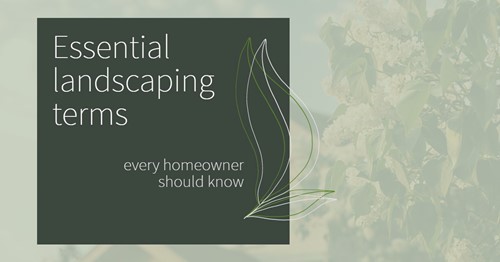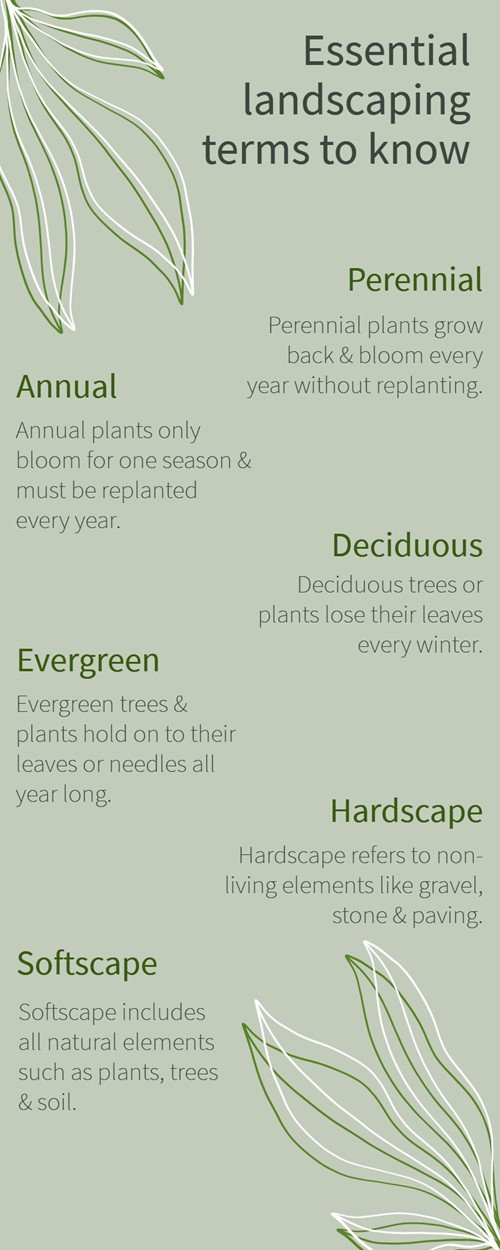
If you’re just getting started with landscaping, it can seem as if it has a language all its own. While landscape designers use specialized terminology to describe the ins and outs of their work, most of the important language overlaps with gardening, architecture and real estate. This means you might already know more about landscaping styles and features than you think!
Regardless of your experience level or goals, knowing the right terms can help you understand the key elements of landscaping. To help, here is a guide to some of the most important terms to know:
Perennial is a term used to describe plants that only need to be planted once to grow and bloom every year. Perennial plants and flowers can last multiple years and even decades with the right conditions and care. Well-established perennials are low maintenance landscape features that can increase your property value, whether located in your front yard or backyard.
As a contrast to perennial plants, annual plants only last one season. This type of plant includes many of the most popular flowering shrubs for increasing curb appeal in outdoor spaces. Annuals make a great landscaping choice for homeowners who like to change the aesthetics of their property’s landscaping regularly.
Deciduous trees or shrubs lose their leaves every winter. However, unlike annual flowers, they don’t need to be replanted every year. Instead, deciduous trees go dormant during the cold season and wake up again in the spring with new growth. Deciduous trees are popular landscaping features for creating shade and adding visual interest to an outdoor space.
Evergreen trees hold on to their leaves or needles all year long. Some popular evergreen shrubs used in landscaping are boxwood, arborvitae and holly. Tall trees like firs, spruce and pine are perfect for adding year-round privacy to landscape design.
Some other evergreen trees like Southern magnolia produce flowers during the spring and summer, but keep their rich green foliage all year.
Hardscape is a term used in landscaping and exterior design to mean any of the non-living or human-made elements in the landscape. Architectural features like paved patios count as hardscape elements, as do retaining walls, pathways and decorative rock features. Hardscape also includes the fixed features surrounding a swimming pool, permanent fire pit or zen garden.
In landscaping language, the softscape refers to all the living elements in an outdoor space. This includes trees, shrubs, flowers, grass and other vegetation. Depending on the style of landscape architecture, softscape elements can serve as a focal point or simply tie the design together.

Whether your goals are to impress potential buyers with amazing curb appeal, or create a personal oasis in your backyard, knowing these key landscaping terms will help you on your journey.

As a Real Estate Professional my number one goal is to provide exceptional service that leaves my clients happily satisfied. I do this with my commitment to helping you buy or sell your home with the highest level of expertise in your local market. This also means helping you understand each step of the buying or selling process. I do not sell houses, I simply guide my clients through a predetermined series of events to ensure a smooth stress free Real Estate experience. You can count on me to always do what's in your best interest, as I pride myself on being honest, trustworthy, and knowledgeable in the Real Estate market. I understand how important it is to get the best offer for your property, therefore I make it my responsibility to help you achieve these goals. Whether you are buying or selling your primary residence, a second home, investor property, a first time buyer, or just relocating to a new neighborhood, I can help make your home-ownership dreams come true. (First Time Buyer Specialist) (Certified Probate & Trust Specialist)
"A Trusted Name in Sonoma County Real Estate."